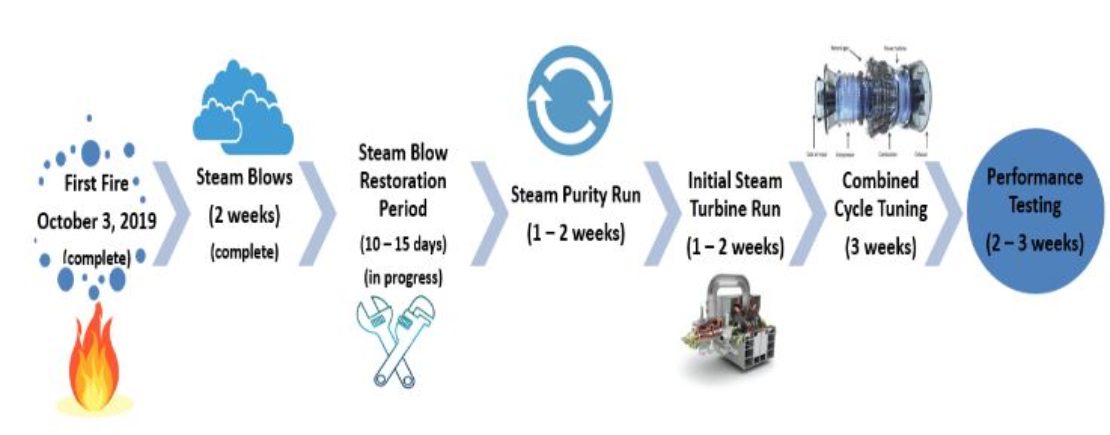The AES power plant in Long Beach’s Marina area is halfway through commissioning its newly installed steam system, which is meant to reduce emissions and environmental impacts once completed, facility officials announced this week.
However, much to the frustration of the surrounding community, the weeks-long startup activities at the Alamitos Energy Center have brought increased noise, odor and visible air emissions from new smoke stacks.
It’s also brought on two violations from the South Coast Air Quality Management District for “visible emissions” observed by inspectors, said spokesman Nahal Mogharabi.
The violations were also issued to AES’ Huntington Beach facility, which has also been commissioning new combined cycle natural gas turbines, according to Mogharabi.
“Visible emissions violations can occur when a source produces uncontrolled smoke, dust, or other particulate matter that reduces visibility and impedes air quality for more than three minutes in one hour,” Mogharabi said.
In a letter to surrounding community members dated Oct. 12, Dalia Gomez, spokeswoman for AES, said the violations involved the shade of the plumes.
“AES understood these plumes as being covered by its air permit,” Gomez stated.
AES has since gone to SCAQMD to receive an approval, called a “variance,” that “exempts AES from the opacity rules during the short start-up period.
Gomez also clarified that the activities will not cause “significant risks with respect to air quality.”
Much of the complaints have taken place during the “first fire” and “steam blows” phases in the past few weeks when the noises, odor and visibility of the plumes were apparent. Community members not only made complaints to AES, SCAQMD and the Long Beach Fire Department, but also took to social media to figure out what was going on.
Some initially confused the source of the activities as the nearby Haynes Steam Plant, operated by the Los Angeles Department of Water and Power.
Gomez said that AES sent letters in advance and held community meetings to inform the community. It has been sending emails to update community members as well.
Why is this coming from the Haynes *Steam* Plant on Studebaker?! It’s been spewing garbage for 24 hours! #LongBeach #longbeachca @RobertGarciaLB @LongBeachPost @LongBeachWater @LongBeachCity pic.twitter.com/zAlUfSGIbK
— haiku/ambulance (@ambulance_haiku) October 6, 2019
AES officials said yellow/light orange plume that was vented from the new stack was a normal part of the commissioning process and the result of oxidized nitrogen. It happened because the pollution control equipment had not been installed yet, resulting in “higher oxides of nitrogen” compared to normal operations and because the turbines were running at much lower rates.
The pollution control equipment has since begun to be installed, Gomez said.
However, when community members reported black plumes earlier this week, Gomez acknowledged that it was not part of the commissioning process, but rather the result of an incomplete combustion, or a lack of oxygen.
Gomez said it was part of an entirely different process that includes the old units that will be replaced. It uses fuel and oxygen to create fire and boil water into steam.
When asked about any potential air quality hazards from these black plumes, Gomez could not comment.
@LongBeachPost
PCH/Marina Pacifica 10:07am
Beautiful air quality pic.twitter.com/i8Pa4fF1cR— Maurice Smith (@Harpoonharri) October 21, 2019
In a letter dated Oct. 21, Gomez stated that the steam blows phase is typically the loudest during the building of a project incorporating a steam turbine.
However, neighbors may still experience noise levels above normal for the area, according to the most recent letter. In response to previous complaints, AES has asked its engineers and operators to re-evaluate remaining commissioning activities to identify and employ any noise-reduction strategies during the temporary work phase.
The next phase in the process is the Steam Purity Run which is expected to last one to two weeks.

Upgrades to the facility began this summer when AES Corp. announced the groundbreaking of a 400 megawatt-hour battery-based energy storage system “as part of a larger modernization and replacement project of the existing AES Alamitos Generating Station.”
The energy storage facility is expected to ensure power flexibility and reliability for Southern California Edison customers “while helping the state meet its aggressive target of 100 percent clean energy by 2045.”
Once the new power plant is in operation it will replace existing ones built in the 1950s.

